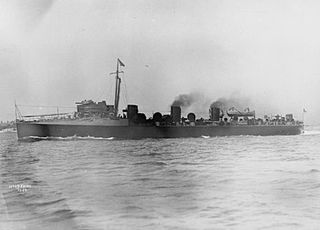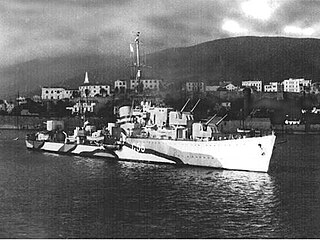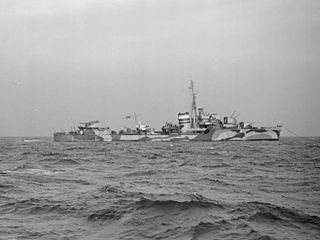This page is based on this
Wikipedia article Text is available under the
CC BY-SA 4.0 license; additional terms may apply.
Images, videos and audio are available under their respective licenses.

Admiral of the Fleet Sir Reginald Yorke Tyrwhitt, 1st Baronet was a Royal Navy officer. During the First World War he served as commander of the Harwich Force. He led a supporting naval force of 31 destroyers and two cruisers at the Battle of Heligoland Bight in August 1914 in which action the 1st Battlecruiser Squadron under Sir David Beatty sunk three German cruisers and one German destroyer with minimal loss of allied warships. Tyrwhitt also led the British naval forces during the Cuxhaven Raid in December 1914 when British seaplanes destroyed German Zeppelin airships and at the Battle of Dogger Bank in January 1915, in which action Tyrwhitt again supported Beatty's powerful battlecruiser squadron.

HMS Badger was an Acheron-class destroyer of the Royal Navy that served during the First World War and was sold for breaking in 1921. She was the eighth Royal Navy ship to be named Badger, after the mammal of the same name.

HMS Punjabi was a Tribal-class destroyer of the Royal Navy that saw service in the Second World War, being sunk in a collision with the battleship King George V. She has been the only ship of the Royal Navy to bear the name "Punjabi" which, in common with the other ships of the Tribal class, was named after various ethnic groups of the world, mainly those of the British Empire.

HMS Calder was a Buckley class Captain class frigate during World War II. It was named after Admiral Sir Robert Calder, Bt. KCB, who was appointed Captain of the Fleet to Admiral John Jervis in 1796, and saw action at the battle of Cape St Vincent on 14 February 1797.

HMS Fairy was a three-funnel, 30-knot destroyer of the First World War. One of three similar ships built by Fairfields for the Royal Navy, she was ordered under the 1896–1897 Naval Estimates and the sixth Royal Navy ship to carry this name. She was classified, along with other similar ships, as a C-class destroyer in 1913. She sank in 1918 from damage inflicted by ramming and sinking the German submarine UC-75.

HMS Mermaid was a Hawthorn Leslie three-funnel, 30 knot destroyer ordered by the Royal Navy under the 1896 – 1897 Naval Estimates. She was launched in 1898, served during World War I and was sold for breaking in 1919.

The Harwich Force originally called Harwich Striking Force was a squadron of the Royal Navy, formed during the First World War and based in Harwich. It played a significant role in the war.

HMS Lightning was an L-class destroyer of the Royal Navy. She was launched on 22 April 1940 and sunk on 12 March 1943 by German Motor Torpedo Boat S-55.

John Cashmore Ltd was a company operating largely in Newport, Monmouthshire, Wales. It became best known for ship breaking and scrapping redundant British railway locomotives.
HMS Colne was a Thornycroft type River-class destroyer ordered by the Royal Navy under the 1903–1904 Naval Estimates. Named after the River Colne in eastern England, north east of London, she was the first ship to carry this name in the Royal Navy.

The first HMS Vehement was a V-class destroyer of the British Royal Navy that saw service in World War I. She spent her short career in minelaying operations in the North Sea before striking a mine and sinking in 1918.

The Battle of the Ligurian Sea was a naval surface action of the Second World War fought on 18 March 1945, in the Gulf of Genoa in the Mediterranean Sea. A Kriegsmarine flotilla of two torpedo boats and one destroyer was conducting an offensive mine laying operation when it was intercepted by a British Royal Navy force. The British destroyers HMS Lookout and Meteor sank two of the German ships and severely damaged the third; it was the last German naval surface action of the war.
HMS Itchen was a Laird-type River-class destroyer ordered by the Royal Navy under the 1901–1902 Naval Estimates. Named after the River Itchen in southern England near Southampton, she was the first ship to carry this name in the Royal Navy.

HMS Chelmer was a Thornycroft type River Class Destroyer ordered by the Royal Navy under the 1903 – 1904 Naval Estimates. Named after the River Chelmer in eastern England, north east of London, she was the first ship to carry this name in the Royal Navy.
HMS Jed was a Thornycroft type River-class destroyer ordered by the Royal Navy under the 1903 – 1904 Naval Estimates. Named after the River Jed in southern Scotland, she was the second ship to carry this name since it was introduced in 1814 for a 26-gun sixth rate ship sold in 1833.

HMS Acasta was an Acasta-class destroyer of the Royal Navy, and the name ship of that class. She was built between 1911 and 1913, and was initially designated a K-class torpedo boat destroyer, having at various times the pennant numbers G40, H59 (1914) or H00 (1918). She saw extensive service during the First World War, including at the Battle of Jutland, where she was badly damaged. She was sold for breaking up in 1921.
The British 3rd Destroyer Flotilla, also styled as Third Destroyer Flotilla, was a naval formation of the Royal Navy from 1909 to 1939 and again from 1945 to 1951.
The British 4th Destroyer Flotilla also known as the Fourth Destroyer Flotilla was a naval formation of the Royal Navy from August 1909 to July 1951.
















